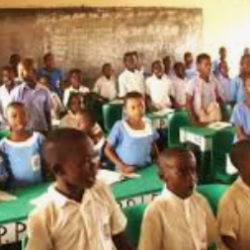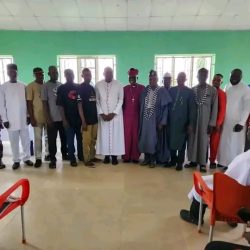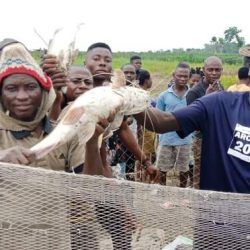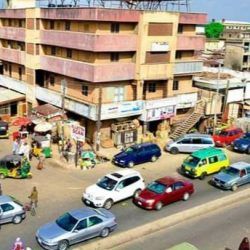Introduction
In recent months, the Sankera region of Benue State, Nigeria, which comprises Katsina Ala, Ukum, and Logo Local Government Areas, has witnessed an unusual calm. The peace that has begun to settle in an area historically wracked by violence and banditry is attributed to the tireless peace initiatives led by Bishop Isaac Dugu of the Catholic Diocese of Katsina Ala. In a significant development, the bishop recently engaged Konyo Amakaa Akwaza, a figure widely regarded as the successor to the infamous warlord Terwase Akwaza, also known as Gana.
This article delves deep into the House of Akwaza, tracing its origins and exploring the roles of Gana, Konyo, and others who have shaped the region’s turbulent history. From the rise of Gana to Konyo’s current leadership, we will explore how the dynamics of power, spirituality, and local politics have affected peace in the Sankera region.
Historical Background of the Akwaza Family
The Origin of the Akwaza Clan
The Akwaza family hails from Mbayongo Council Ward in Katsina Ala Local Government Area of Benue State. The patriarch of the family, Pa Akwaza Zoho Kpam, was a respected figure who fathered five children. His descendants would later shape the destiny of their region, for better or for worse.
Pa Akwaza Zoho Kpam and His Legacy
Pa Akwaza Zoho Kpam married once and had five children: Amakaa Akwaza, Shimave Akwaza, Iornder Akwaza, Kpemna Mike Akwaza, and Nyiaor Akwaza. Among these, it was initially Mr. Kpemna Mike Akwaza who gained prominence as a teacher and principal, while his brother Ortar Amakaa Akwaza became the clan head.
The Children of Pa Akwaza: Who Are They?
Before the rise of Terwase Iornder Akwaza, also known as Gana, it was Kpemna Mike Akwaza who had the highest public profile within the family. He mentored his nephews, Terwase and Aondofa Amakaa Akwaza, better known as Azonto. It was under the care of Mr. Mike that Terwase, who would later become Gana, began to venture into the criminal underworld.
The Rise of Gana: Terwase Iornder Akwaza’s Early Life
School Days in Tor Donga
Terwase Akwaza attended Shitile Community Secondary School in Tor Donga, where he stayed with his uncle, Mr. Kpemna Mike Akwaza. It was during his time at school that Terwase began showing signs of delinquency. His physical strength, combined with his unsettling fetish practices, set him apart from other students.
The ‘Ghana Must Go’ Bag Story and the Birth of the Name ‘Gana’
The nickname “Gana” stemmed from Terwase’s frequent appearances at school with a large “Ghana Must Go” bag, often filled with stolen items. His petty crimes, combined with his use of charms and amulets, made him both feared and notorious among his peers. A teacher began calling him the “Ghana Must Go boy,” which eventually became “Gana.”
From Petty Criminal to Warlord
What began as small-time theft escalated when Gana dropped out of school and became involved in more serious criminal activities. By the early 2000s, he had transformed into a formidable warlord, gaining experience and arms during the Kuteb and Jukun ethnic crises. His rise to power marked the beginning of a reign of terror in Benue State, which lasted until his death in 2020.




The Evolution of Gana as a Notorious Warlord
Gana’s Role in the Kuteb and Jukun Crises (2003)
Gana’s involvement in the 2003 Kuteb and Jukun crises was a turning point in his criminal career. The conflicts, which erupted between these two ethnic groups in Taraba State, provided him with the opportunity to amass arms and recruit loyal followers. Gana’s ability to manipulate the chaos allowed him to build a network of bandits and militants that would later form the backbone of his operations in Benue.
Political Ties and Influence (2003–2015)
By 2003, Gana had become a central figure in Sankera’s criminal underworld, and his power was further entrenched through political connections. Local politicians seeking to secure their electoral victories often turned to Gana and his gang for support. This mutually beneficial relationship ensured Gana’s survival and allowed him to operate with near impunity for over a decade.
Attempts to Capture Gana and His Elusiveness
Throughout his reign, numerous attempts were made by both state and federal authorities to capture Gana. However, he consistently evaded arrest, thanks to his military strategies and, according to local belief, his spiritual protections. His reputation as an elusive and almost supernatural figure grew with every failed attempt to bring him to justice.
The Amnesty Offers: Gana’s Relationship with Benue Government
Samuel Ortom’s 2015 Amnesty Initiative
When Samuel Ortom became the governor of Benue State in 2015, he extended an amnesty offer to bandits and militants, including Gana. In a surprising move, Gana initially accepted the amnesty, surrendering some arms and promising to turn over a new leaf. This move was seen as a potential breakthrough for peace in the region.
Why the First Amnesty Failed
Despite his initial acceptance, Gana eventually reneged on the amnesty deal. Various factors, including distrust between Gana and the government, as well as lingering political rivalries, contributed to the collapse of the peace initiative. Gana returned to his violent ways, further entrenching his control over Sankera.
The Second Amnesty and Gana’s Assassination (2020)
A second attempt at amnesty was initiated in 2020, and Gana again expressed interest. However, as he was en route to accept the terms, he was intercepted and killed by the military. This marked the end of his reign but left a power vacuum in the region, setting the stage for his cousin, Konyo, to rise as the new leader.
Spiritual Powers and Mysticism Surrounding Gana
Gana’s Alleged Spiritual Powers
Throughout his life, Gana was believed to possess supernatural powers that protected him from harm. His use of amulets, charms, and other fetish objects contributed to his aura of invincibility. Many in Sankera believed that Gana’s spiritual strength was the key to his long survival and ability to evade capture.
The Role of Amulets and Fetishes in Gana’s Survival
Stories of Gana’s reliance on mystical objects were widespread. His famous “Ghana Must Go” bag was said to contain powerful amulets that shielded him from bullets and gave him the ability to disappear at will. These beliefs made him both feared and revered in the local community.
The Transition of Spiritual Powers to Konyo
Before his death, Gana is said to have passed on his spiritual powers to his younger cousin, Konyo Amakaa Akwaza. This transfer of power was both symbolic and practical, as Gana reportedly foresaw his impending death. The spiritual mantle now rests on Konyo, who has inherited not only Gana’s gang but also his mystique.
Konyo Amakaa Akwaza: The New Leader
Who Is Konyo Amakaa Akwaza?
Konyo Amakaa Akwaza, Gana’s cousin, was relatively unknown before Gana’s death. However, since assuming leadership, he has gained notoriety as “The Overall,” a title that signifies his authority over the remnants of Gana’s gang. His leadership style is less overtly violent than Gana’s, but he commands the same fear and respect in the region.
Konyo’s Role After Gana’s Death
After Gana’s assassination, Konyo stepped into the vacuum left behind. He quickly consolidated power, rallying the remaining loyalists to continue the family’s reign over Sankera. However, unlike Gana, Konyo has shown a willingness to engage in peace talks, particularly with the Catholic Church.
Konyo’s Acceptance of Peace Initiatives
In a surprising move, Konyo recently accepted an olive branch extended by Bishop Isaac Dugu. This development has raised hopes for lasting peace in Sankera, though many remain skeptical. Konyo’s public appearance at the peace table has been hailed as a breakthrough, but only time will tell if his commitment to peace is genuine.
The Role of the Catholic Church in Sankera’s Peace Efforts
Bishop Isaac Dugu’s Involvement
Bishop Isaac Dugu has emerged as a key figure in the peace efforts in Sankera. Through his work as the Catholic bishop of Katsina Ala Diocese, he has initiated dialogues with local bandits, including Konyo. His mediation efforts have been instrumental in bringing bandits to the negotiating table.
Past Peace Initiatives in Sankera
Before engaging Konyo, Bishop Dugu had toured other parts of Sankera, meeting with various factions of bandits in Logo and Ukum Local Government Areas. These initiatives, though modest in their results, laid the groundwork for broader peace talks in the region.
Meeting with Konyo: A Turning Point?
The meeting between Bishop Dugu and Konyo has been seen as a major turning point in the search for peace. Konyo’s willingness to engage in dialogue is a significant departure from his cousin Gana’s approach, raising hopes for a long-term resolution to the violence in the region.
The Power Struggles Within the Akwaza Family
The Role of Azonto (Aondofa Amakaa Akwaza)
Azonto, another cousin of Gana and Konyo, played a key role in the Akwaza family’s criminal operations. After Gana’s death, Azonto sought revenge against those he believed were responsible. However, his efforts were cut short when he was arrested in 2021.
Azonto’s Arrest and Disappearance (2021)
Following his arrest in 2021, Azonto disappeared from public view, and his current whereabouts remain unknown. His removal from the scene left Konyo as the undisputed leader of the Akwaza family’s operations, though rumors of Azonto’s potential return continue to circulate.
Family Dynamics and the Struggle for Control
The Akwaza family has been marked by internal power struggles, with various members vying for control over the family’s operations. While Konyo currently holds the mantle of leadership, the potential re-emergence of figures like Azonto could complicate the fragile peace that is beginning to take root.
Impact of Banditry and Violence on the Sankera Region
Katsina Ala, Ukum, and Logo Local Government Areas: The Epicenter of Violence
The Sankera region, particularly the local government areas of Katsina Ala, Ukum, and Logo, has been at the heart of the violence orchestrated by Gana and his gang. The impact of banditry in these areas has been devastating, with entire communities displaced and infrastructure destroyed.
Banditry in Sankera: Root Causes and Consequences
The roots of banditry in Sankera can be traced to a combination of poverty, political manipulation, and ethnic tensions. The violence has disrupted social and economic life, leaving a generation of young people without education or prospects for the future.
Local Politics and Banditry in Benue State
The Role of Politicians in Empowering Bandits
Local politicians have often been complicit in the rise of banditry, using criminal groups like Gana’s gang to secure electoral victories. This symbiotic relationship between politics and crime has made it difficult to dismantle the bandit networks in Benue State.
How Gana’s Gang Influenced Elections
Gana’s gang played a significant role in influencing local elections by intimidating voters and eliminating political rivals. This allowed Gana to establish a foothold in the political landscape, making it nearly impossible for the government to act against him without risking political fallout.
Current Political Climate in Sankera
In the aftermath of Gana’s death, the political climate in Sankera remains tense. While some politicians have distanced themselves from the bandit groups, others continue to rely on criminal networks to maintain their influence. This has created a volatile situation where peace remains fragile.
The Future of Peace in Sankera
Will Konyo’s Acceptance of Peace Hold?
Konyo’s recent acceptance of the Catholic Church’s peace initiative is a positive development, but it remains to be seen whether this peace will last. Skepticism abounds, as previous efforts to broker peace with bandits in Sankera have failed. However, Konyo’s willingness to engage in dialogue offers a glimmer of hope.
Challenges Facing Long-Lasting Peace in the Region
The road to lasting peace in Sankera is fraught with challenges, including deeply ingrained mistrust between the government, bandits, and the local population. The region’s political instability and the entrenched nature of criminal networks make it difficult to achieve a permanent solution.
The Role of Local and State Government in Maintaining Stability
The involvement of the local and state government will be crucial in ensuring that the peace process initiated by the Catholic Church is successful. This will require a multifaceted approach, including the provision of economic opportunities, infrastructure development, and the demobilization of bandits.
The Socio-Cultural Impact of Banditry in Benue
The Effect of Gana’s Reign on Community Life
The reign of Gana left a lasting impact on the social and cultural fabric of Sankera. Many communities were forced to flee their homes, and a culture of fear permeated the region. The normalization of violence has left deep scars that will take years to heal.
How Konyo’s Leadership May Shape Future Generations
As the new leader of the Akwaza family, Konyo has the potential to shape the future of Sankera. If he continues to engage in peace efforts, he may help to rebuild the region and restore a sense of normalcy. However, if he reverts to violence, the cycle of destruction will continue.
Rebuilding Trust in Sankera’s Communities
Rebuilding trust between the people of Sankera and their leaders, both political and criminal, will be essential to creating a peaceful future. The role of institutions like the Catholic Church will be critical in facilitating this healing process.
Lessons from the Story of Gana and Konyo
The Impact of Crime on Leadership in Rural Communities
The story of Gana and Konyo highlights the complex relationship between crime and leadership in rural communities. In regions like Sankera, where state authority is weak, criminal leaders often fill the void left by the government, providing both protection and oppression.
The Importance of Spirituality in Bandit Culture
Spirituality plays a significant role in the culture of banditry in Benue State. Figures like Gana and Konyo are not just feared for their physical power but also for their alleged spiritual abilities, which add an extra layer of control over their followers.
The Role of Family in Leadership Transitions
The transition of leadership within the Akwaza family, from Gana to Konyo, underscores the importance of familial ties in maintaining power. In many rural communities, leadership is passed down through family lines, making it difficult to break cycles of violence.
Frequently Asked Questions (FAQs)
What was the origin of Gana’s power?
Gana’s power originated from his involvement in the Kuteb and Jukun crises, where he gained arms and followers. His control over the region was further solidified through political connections and his reputed spiritual powers.
Who is Konyo Amakaa Akwaza?
Konyo Amakaa Akwaza is Gana’s cousin and the current leader of the Akwaza family’s criminal operations. He has recently engaged in peace talks with the Catholic Church, raising hopes for a cessation of violence in Sankera.
How did Gana evade capture for so long?
Gana evaded capture through a combination of military tactics, political connections, and alleged spiritual powers. His use of amulets and charms contributed to his aura of invincibility.
What is the role of the Catholic Church in resolving banditry in Sankera?
The Catholic Church, led by Bishop Isaac Dugu, has played a key role in mediating peace talks between bandits and the government. Their involvement has been crucial in bringing figures like Konyo to the negotiating table.
Will Konyo’s leadership bring lasting peace?
While Konyo has publicly accepted peace initiatives, it remains uncertain whether his leadership will result in long-lasting peace. The region’s history of violence and political instability poses significant challenges to sustained peace.
What happened to Azonto, Gana’s cousin?
Azonto, another cousin of Gana, was arrested in 2021 during a revenge spree following Gana’s death. His whereabouts remain unknown, and his disappearance has fueled speculation about his potential return to the region.
Conclusion: The Road Ahead for Sankera
The story of the Akwaza family, from Gana to Konyo, is a complex one filled with violence, spirituality, and power struggles. As Sankera takes tentative steps toward peace, the role of leaders like Konyo and institutions like the Catholic Church will be critical. Whether this newfound calm will last depends on the region’s ability to address the root causes of violence, rebuild trust, and create opportunities for its people.















